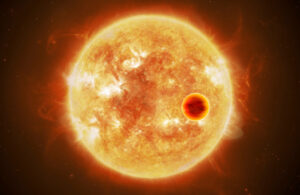
Credits: ESA/ATG medialab, CC BY-SA 3.0 IGO
Dedicated to studying the atmospheres of planets orbiting stars other than the Sun, Ariel (Atmospheric Remote-Sensing Infrared Exoplanet Large-survey) will observe a varied sample of exoplanets – from gas giants to Neptunian-type planets, super-Earths and terrestrial planets – in the frequencies of visible light and infrared. It will be the first space mission to carry out a “census” of the chemical composition of planetary atmospheres, providing fundamental clues to understand the mechanisms of formation and evolution of the planets beyond the Solar System, to fully frame the role of our planetary system in the cosmic context , and address the complex questions concerning the origin of life in the universe.
Ariel’s eye, a telescope with an elliptical mirror measuring one meter in diameter to collect visible and infrared light from distant planetary systems, will be made in Italy, as will the on-board electronics. By breaking down light into all its “colors” using onboard spectrometers, it will be possible to identify the chemical elements present in the atmospheres of exoplanets observed during their passage, or transit, in front of or behind the host star.
Ariel will be launched with an Ariane 6 rocket from the ESA base of Kourou, in French Guiana, and put into orbit around the Lagrange 2 point (L2), a gravitational balance point 1.5 million kilometers from Earth, in the opposite direction. to that of the Sun. From this position, the telescope will have a clear view of the entire sky to scrutinize in detail exoplanets already discovered by other observers.
The mission will be the fourth middle-class mission of ESA’s Cosmic Vision program to be launched in 2028 and will be carried out by an international consortium in which Italy plays a very important role.
Italy, with the support of the Italian Space Agency, expresses two Co-Principal Investigators, both of INAF, supported by a team that includes numerous other scientists and structures of the National Institute of Astrophysics in addition to the University of Florence, the Institute of Photonics and Nanotechnologies of the Cnr of Padua and the Sapienza University of Rome.
OAS involvement
- Payload Thermal Design and analysis,
- contribution to the Telescope Assembly,
- Telescope AIV,
- activities PA/QA payload and IOSDC,
- CoPI-ship of the mission,
- contribution to the Ground Segment and responsibility of the Mission’s Instrument Operations and Science Data Center (IOSDC).
For more information:
– https://www.media.inaf.it/2020/11/12/ariel-adopted/
– https://www.media.inaf.it/2018/03/20/ariel-editoriale-giusi-micela/
– https://www.media.inaf.it/2018/03/20/ariel-atmosfere-degli-esopianeti-senza-segreti/
– https://sci.esa.int/web/ariel
– https://arielmission.space
– https://www.asi.it/2020/11/ariel-locchio-nello-spazio-che-indaghera-le-atmosfere-degli-esopianeti/
Hot exoplanet. Credits: ESA/ATG medialab, CC BY-SA 3.0 IGO
